Explore the fascinating origins of Halloween as we delve into the ancient Irish festival of Samhain. Discover quirky Irish Halloween traditions that shaped today’s spooky celebrations. Join us on a journey through folklore, rituals, and the ghosts that haunt this festive night!
Halloween Started in Ireland!
Halloween is often seen as a holiday for children, filled with candy and costumes, but its rich history reveals a captivating story that dates back to ancient Ireland. Explore the fascinating history and Irish origins of Halloween, uncovering the bewitching mystery and merriment that began with the Celtic festival of Samhain. From tall tales of spirits to the delightful traditions surrounding Irish Halloween food, there’s much more to discover than just sweets and tricks. Have you ever tasted a slice of warm Barmbrack? This traditional treat not only warms the soul but also reveals fortunes for the coming year! As we delve into the enchanting Irish customs, you might just find yourself as captivated by Halloween as I am, knowing that its roots run deep in the rich tapestry of Irish culture.


The Irish origins of Halloween continue to be celebrated today. Photo: Tourism Ireland.
Do you KNOW the Irish origins of Halloween ?
Irish Halloween traditions involve the whole family in a quirky set of predictions, promises and feasting. It draws from the ancient Celtic festival of Samhain, which falls on the last day of October, just like Halloween. Samhain is about celebrating the harvest with a huge feast of the season’s produce.
Ireland really gets into Halloween with haunted happenings and wailing banshees, along with plenty of tricks, treats and festivals, making it a wonderful time to visit. Derry (officially known as Londonderry) in Northern Ireland turns into a ‘City of Bones’ with inflatable monsters, banshee bike rides and fireworks from October 28 to November 1.
In Dublin, the capital of the Republic of Ireland, the Bram Stoker Festival delves into the legacy of Dracula’s Dublin-born creator from October 30 to November 2.
Across the counties of Meath and Loth, the Puca Festival includes a recreation of the symbolic lighting of the Samhain fires on the Hill of Ward near Athboy on October 31. My Heaney ancestors came from the adjacent county of Caven, so they probably celebrated in similar ways before emigrating to Australia in the 1880s. The Púca Festival (pronounced poo-kuh) is a chance to indulge in traditional barm brack, colcannon, baked apples and other local seasonal treats. There will also be a Banshee Bingo Hall, comedy witch trials, interactive werewolf games, self-guided treasure hunts, and traditional handfasting ceremonies.
According to Irish and Celtic traditions, Puca a shape-shifting character that comes alive at the ancient new year to roam the night and change the fortunes of those who cross it. You might also meet Morrigan, the goddess of war, Fear Dearg, the faerie of mischief and Boann, the goddess of the Boyne.
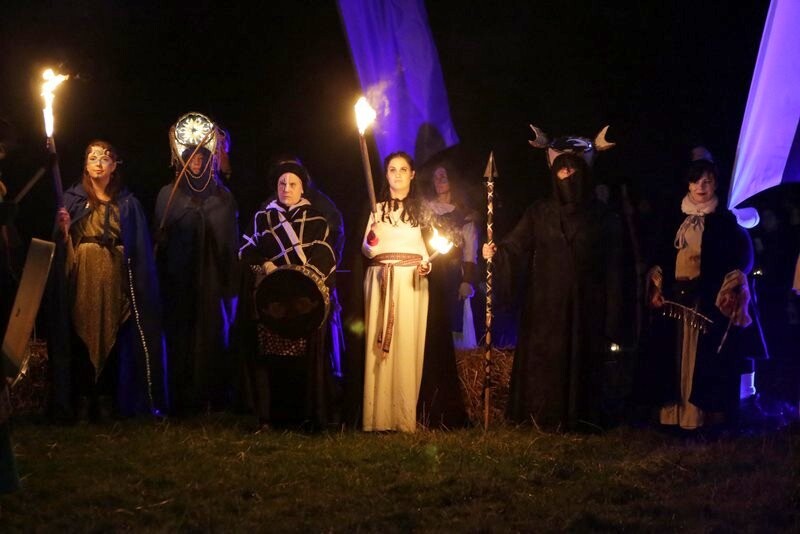
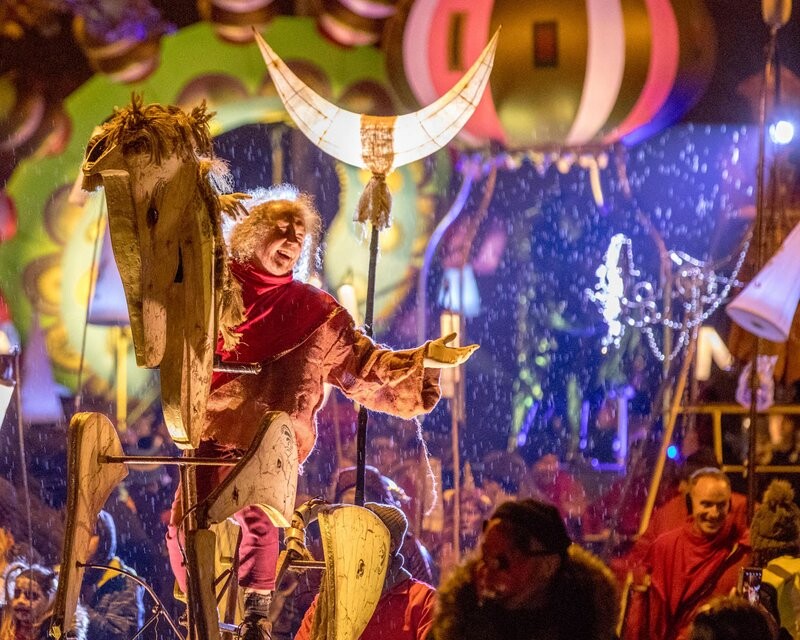
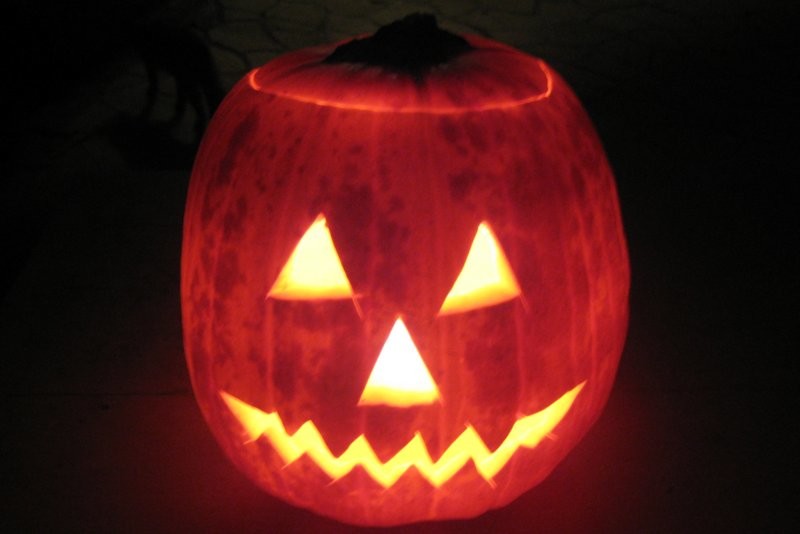
Irish Halloween traditions include the Jack O Lantern. Photo: Kerry Heaney
Irish Halloween traditions
It’s fascinating to learn that many of the traditions we associate with an American Halloween actually have their origins in Irish Halloween traditions. Take trick-or-treating, for instance—it began with poor Irish children going door to door asking for food, money, or kindling. (Can you imagine that today?) In return for their songs and prayers, they were given a soul cake, a piece of bread filled with fruit.
Another well-known custom, the Jack O’ Lantern, is also an Irish Halloween tradition. The first lanterns weren’t carved from pumpkins but from turnips or large potatoes. The name comes from an Irish folk tale about Stingy Jack, who tried to trick the devil. As punishment, the devil condemned him to wander the earth forever, lighting his way with nothing but a burning ember inside a hollowed-out turnip.
When Irish immigrants brought these traditions to America, home of the pumpkin, they blended with local customs to create the Halloween we know today. It’s no surprise that Halloween’s Irish origins are at the heart of this beloved celebration!
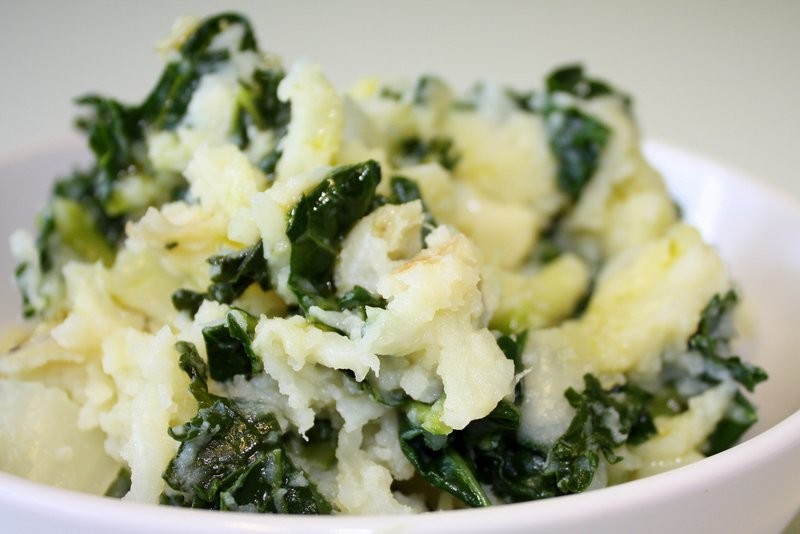
You might call this mashed potato, but in Ireland it is colcannon and a traditional Irish Halloween food. Photo: Tourism Ireland.
Irish Halloween food
Halloween started in Ireland with Samhain. This is a great festival of fire and feasting that marks the change of season. It is the end of the season of light and the beginning of dark days.
Samhain recipes feature turnips, nuts, gourds and apples, apple cider, ale and mulled wines along with beef, pork and poultry. As the harvest work halted, the community came together for feasting started. The Celts enjoyed eating the fruits of their labour. They told stories and tried to predict their fortunes.
The original traditional Halloween foods were potato dishes such as champ (mashed potatoes with spring onion or chives) and a hearty colcannon (mashed potatoes and kale or green cabbage) dinner. Eat them the traditional way and dip each spoonful into a well of butter. Boxty is potato pancakes made with grated raw potatoes and buttermilk pan-fried until golden.
Fadge is made using a cake batter created using freshly boiled potatoes, melted butter and flour and a pinch of salt with a layer of apples added before baking. When the cake is almost done, the pastry lid is turned back, and butter and brown sugar is sprinkled over the apples to make a sauce.
Fruit, nuts and barmbrack bread are other Irish traditions for Halloween.
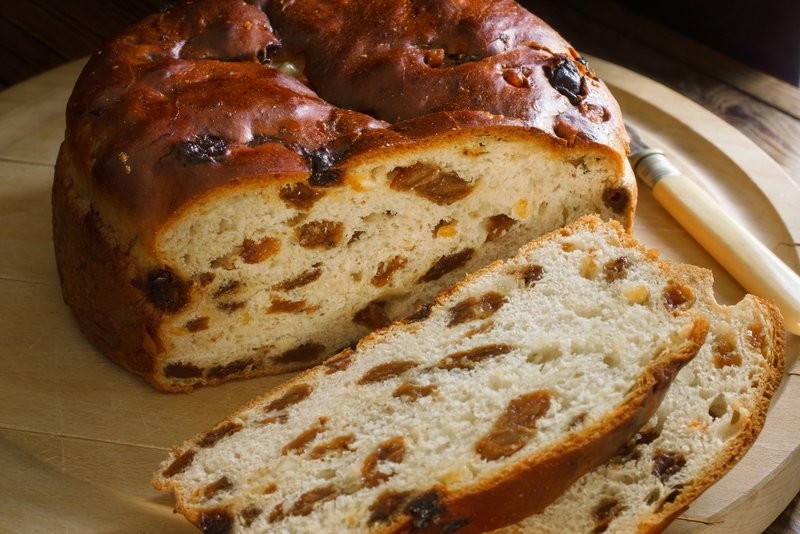
A slice of Barmbrack studded with charms is an intriguing Irish Halloween food. Photo:
A slice of Barmbrack tells your fortune
Barmbrack is eaten all year round, but at Halloween fortune telling charms are added to the mix. The fruits can be soaked in whiskey, tea, or both, to give richness to the flavour.
Back in the day, Irish homes would be filled with the smell of baking bread and barmbrack cooking over the open fire. Barmbrack is a dried fruit-studded bread. The name comes from the Irish ‘bairín breac’, which means speckled loaf.
The Irish Halloween food tradition is that everyone gets a slice of the bread, but you need to careful when biting into it! You may find that something has been hidden inside that will tell your fortune for the year ahead.
If you find a ring, expect the discovery of true love and a wedding. Find a thimble, and you will never marry. Those who have a rag in their piece can expect a period of poverty while anyone finding a coin will be rich. I’ll have a coin, please.
There are more charms with meanings that can be found in your brack. A stick or matchstick means an unhappy relationship or major argument while a thimble signifies a period of independence/singlehood. A button means bachelorhood. Pretty gloomy predictions, so I think I might pass on a slice.
If you would like to celebrate Halloween or Samhain by making your own Barmbrack and continue the tradition that Halloween started in Ireland, I have an easy recipe at the end of this post.
Barmbrack is the Irish Halloween food that tells your fortune.
An apple a day but not at Samhain
Although apples have long been associated with Halloween, the Irish Halloween food tradition warns against picking them during this time. Why? Because the púca (fairy shapeshifters) were thought to spit on them the night after Samhain! That’s why creepy apple bites, apple monsters, and apple pies with ghost-white cream have become popular treats for children celebrating Halloween. The blend of Irish Halloween traditions with these spooky customs adds a unique flavour to the festivities!
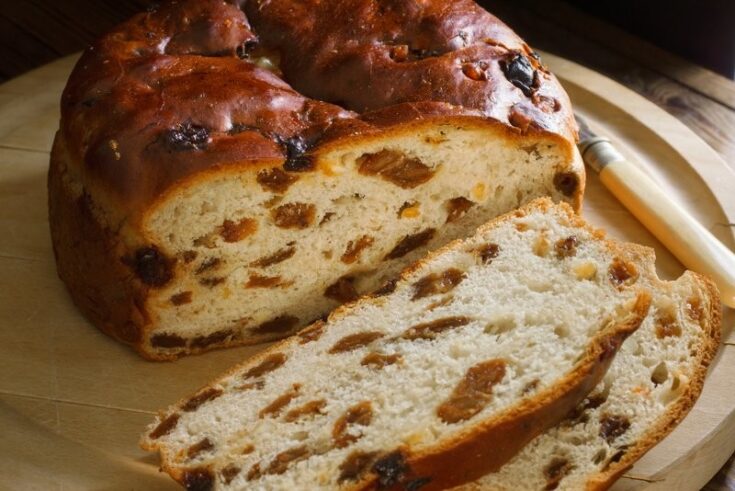
How to make an Irish Halloween tradition - Barmbrack
Baking Barmbrack is an Irish Halloween food tradition that comes with fortune-telling opportunities if you include some charms. Remember, Halloween started in Ireland, so you could experience the luck of the Irish and receive the best charm!
Ingredients
Fruit Mix
- 350g (1½ cups) sultanas
- 50ml (¼ cup) Bushmills whiskey
- Warm tea (enough to cover the sultanas)
- 1 lemon, juice and zest
Dough
- 450g (2 cups) strong bread flour
- salt, pinch
- 15g (1 tbsp) dried yeast
- 280ml (9.5fl oz) room temperature milk
- 50g (3½tbsp) butter, softened
- 50g (3½tbsp) sugar
- 1 beaten egg
Topping
- 1 tbsp butter
- 1 tsp ground cinnamon
- ½t tsp ground mixed spice
Instructions
 Soak the sultanas in the whiskey, lemon juice and warm tea for 30-45 minutes, then drain off the liquid.
Soak the sultanas in the whiskey, lemon juice and warm tea for 30-45 minutes, then drain off the liquid.- To make the dough, put all the ingredients into a mixing bowl and mix with a wooden spoon.
- Knead the dough on a floured surface with your hands for five minutes.
- Put the dough in a bowl, then cover with a damp tea towel. Leave it for about 1 hour until the mixture has risen and fills the bowl.
- Knead the dough again on a floured surface, adding soaked fruit until evenly spread throughout the mixture.
- Place it in a 20-23cm buttered cake tin, then cover with a damp tea towel.
- Leave in a warm place for about 20 minutes until the mixture rises up to the top of the tin.
- Bake for 50 minutes in an oven preheated to 200C.
- To make the topping, cream the butter and spices together until soft.
- Remove the barmbrack from the oven. Immediately spread spiced butter on top. Leave to cool.
Nutrition Information:
Yield:
12Serving Size:
1Amount Per Serving: Calories: 76Total Fat: 2gSaturated Fat: 1gTrans Fat: 0gUnsaturated Fat: 1gCholesterol: 20mgSodium: 35mgCarbohydrates: 10gFiber: 0gSugar: 1gProtein: 3g
Eatdrinkandbekerry.net offers nutritional information for recipes contained on this site. This information is provided as a courtesy and is an estimate only.
More Irish food traditions
St Patrick’s Day is another big Irish tradition, and it involves wearing and eating the green! Try these St Patrick’s Day cupcakes for a fun day.
Another Irish tradition that I discovered when wandering Belfast’s St George Markets is eating seaweed from a paper packet.
Disclaimer: Thanks to Tourism Ireland for sharing the true origin of Halloween. Find out more about visiting Ireland at Tourism Ireland.

